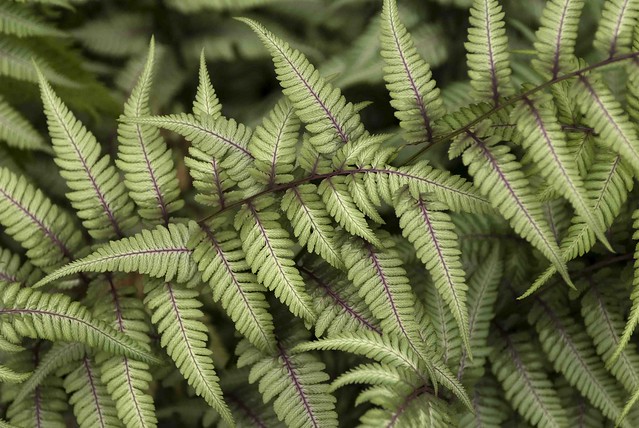

There's a general consensus that sun-filled gardens are more exciting than shade gardens. In reality, however, shade gardens offer equal opportunities for creating eye-catching vignettes.
A few basic steps need to be followed when embarking on a shade garden. First, assess the amount of sun your garden receives. The hours of sunlight vary in different areas of your garden and will determine the types of plants that you use. How dense is the shade? What time of day do you get sun; is it gentle morning sun or stronger afternoon sun? What type of soil do you have, wet or dry? Is there root, water and nutrient competition from surrounding trees?
The next step is to amend your soil. Adding organic matter is always a good idea. The best time to do this is in late spring or early fall, when the ground is workable (not too wet or frozen). Nature replenishes the soil with decomposing fallen leaves; essentially you are doing the same when amending the soil.
When starting a garden, organic matter, such as compost or leaf mulch, can be incorporated into the soil and dug in 6-8 inches deep. For established gardens, a 1-3-inch layer of leaf mulch, compost, pine needles (slow to break down), or fine, pine bark mulch can be added to the surface. Be careful when digging around mature trees. The feeder roots (the roots that take up nutrients and water) are always very shallow and should not be disturbed.
Shade gardens are no different from other types of gardens in that they require structure. Hardscapes such as stone walls, benches, water features, and paths all contribute to a garden's structure. Trees play leading roles as well. Flowering understory trees such as Canadian redbuds (Cercis canadensis) add ornamental value.
Shrubs add volume, structure, color and form to the shade garden. Witch-hazels (Hamamelis) brighten the garden with fragrant midwinter flowers and add structure with their vase-shaped form. Azaleas add color, form and height in areas of dappled shade. The flame azalea (Rhododendron calendulaceum) comes in bright yellow and orange, while the pale pink roseshell azalea (Rhododendron prinophyllum) is intensely fragrant.

When designing a shade garden, it is important to make maximum use of foliage textures, forms, and colors. Repeating patterns throughout the garden adds cohesion to the design. Contrasting feathery or wispy leaves with broad foliage also works effectively, using shapes as well as color to define the design.
Color combinations in the shade garden can be subtle yet powerful. Pairing Japanese painted fern (Athyrium niponicum var. pictum) with a purple-leaved coral bell (Heuchera 'Stormy Seas', 'Montrose Ruby', 'Gypsy Dance' or 'Geisha's Fan') brings out the silver and purple hues in both plants. The feathery ferns complement the broad-leaved coral bells, creating an interesting combination.
Ferns are wonderful foils and centerpieces in the shade garden. Two favorites are autumn fern (Dryopteris erythrosora) and maidenhair fern (Adiantum pedatum). Autumn fern has coppery, spring foliage that turns green as the season advances. Maidenhair fern is one of the most unusual, with feathery fingers that radiate in all directions.
Remember that some ferns, such as hay-scented fern (Dennstaedtia punctilobula) and ostrich fern (Matteuccia struthiopteris), can spread rapidly. Lady fern (Athyrium filix-femina), on the other hand, is well behaved and a welcome addition to any garden.
Blue-leaved hostas will brighten up a green fern, highlight pink or white astilbe flowers, or accentuate a lime-green hosta such as the fragrant Hosta 'Holy Mole'. Examples such as Hosta 'Blue Wedgewood' or Hosta sieboldiana var. elegans can intensify the colors of neighboring plants while creating a sense of calm.
Showy variegated and bright golden hostas are eye-catching; just remember to combine them with more subtle plants to balance the display. Blue, green, and lightly variegated hostas will not out compete their neighbors. Pairing hostas with feathery or fine foliage plants creates good contrast and an instant display. Most hostas do best in dappled shade or with morning sun. Sun early in the day isn't hot enough to scorch their leaves.
One of the biggest problems with hostas is that they act as slug magnets. If slugs are a problem, they can be handled with environmentally friendly products that contain iron phosphate (e.g. Sluggo®) or with home remedies. Used coffee grounds are an option--just make sure they are caffeinated, because it's the caffeine that harms the slugs. Half a used grapefruit rind or a small wooden board can act as slug traps; slugs hide under these dark, moist surfaces during the day and can be collected and discarded. Thick-leaved hostas tend to be more slug-resistant.

Grasses and sedges are wonderful additions to the shade garden. The ever-popular Japanese hakone grass (Hakonechloa) gracefully cascades in colors ranging from green to bright yellow. The most common variety is Hakonechloa macra 'Aureola' with bright gold foliage streaked with green. These grasses age well and provide excellent winter interest for the late-season garden.
Sedges are equally versatile. Variegated broad leaf sedge (Carex siderosticha 'Variegata') brightens up any shady spot with broad green leaves and white piping. If you have partial shade, Bowles' golden sedge (Carex elata 'Aurea') provides a splash of color while the golden fountain sedge (Carex 'Golden Fountains') supplies golden highlights for full shade.
The fine leaves of golden sedges and grasses contrast beautifully with broad, purple-leaved ligularia (Ligularia dentata) or feathery, purple-leaved bugbane (Actaea simplex Atropurpurea Group 'Black Negligee' or 'Brunette'). Variegated, broadleaf sedge picks up whites and creams in variegated hosta such as Hosta 'So Sweet' or 'Patriot'.
Once the structure of your shade garden is in place with beautiful shrubs and perennials, it's important to complete the design with added color from annuals. There is more then the proverbial impatiens. Nonstop flowering begonias, Rex begonias, flowering tobacco (Nicotiana), torenia (Torenia), browallia (Browallia), and coleus are just a few options.

-- For a list of shade tolerant plants, click on the tab at the top of this page called "Shady Plant Selections"